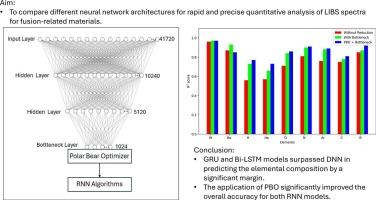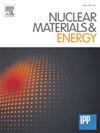评估DNN和RNN用于确定熔合基材料的降维LIBS光谱的化学成分
IF 2.7
2区 物理与天体物理
Q1 NUCLEAR SCIENCE & TECHNOLOGY
引用次数: 0
摘要
激光诱导击穿光谱(LIBS)通常被称为原位快速分析技术。虽然实验设置相对简单,但对含有多种元素的样品中的元素进行定量,对更快、更可靠的定量提出了挑战。机器学习(ML)技术的应用是实现实时量化结果的最佳解决方案之一。本文研究了深度神经网络(DNN)、门控循环单元(GRU)和双向长短期记忆(Bi-LSTM)模型在热核反应堆第一壁材料组成分析中的性能。该数据集基于7400个模拟光谱,分辨率为4000,每行包含41730个数据点。初步评估显示,GRU和Bi-LSTM模型在捕获光谱数据关系方面优于DNN, R2得分更高,均方误差(MSE)更低。为了降低计算复杂度和消除冗余数据,采用瓶颈方法将特征空间减少到1024个,同时提高了预测性能。通过使用Polar Bear Optimizer (PBO)进行超参数调优,进一步增强了模型的整体精度。将降维和超参数优化技术相结合,可以显著提高递归神经网络(RNN)模型的预测能力。本研究强调了机器学习技术在解决与复杂融合相关样品中元素快速定量相关的挑战方面的潜力。本文章由计算机程序翻译,如有差异,请以英文原文为准。

Evaluation of DNN and RNN for the determination of the chemical composition of dimensionality-reduced LIBS spectra of fusion-based materials
Laser Induced Breakdown Spectroscopy (LIBS) is often referred to as an in-situ and rapid analysis technique. Although the experimental setup is relatively simple, the quantification of elements in a sample containing multiple elements poses challenges for faster and reliable quantification. The application of machine learning (ML) techniques is one of the optimal solutions to achieve the quantified result in real-time. This study investigates the performance of Deep Neural Network (DNN), Gated Recurrent Unit (GRU), and Bidirectional Long Short-Term Memory (Bi-LSTM) models in analyzing the composition of first wall materials of thermonuclear reactors. The dataset was modelled based on 7400 simulated spectra at a resolution of 4000, each row comprising 41,730 data points. Initial evaluations revealed that GRU and Bi-LSTM models outperformed DNN in capturing spectral data relationships, as indicated by higher R2 scores and lower Mean Squared Error (MSE). To mitigate computational complexity and eliminate redundant data, a bottleneck approach was used, which reduced the feature space to 1024 while enhancing predictive performance. Further enhancements were achieved through hyperparameter tuning using Polar Bear Optimizer (PBO), leading to significant improvements in the overall model accuracy. The integration of dimensionality reduction and hyperparameter optimization techniques demonstrated significant enhancement in the predictive capabilities of Recurrent Neural Network (RNN) models. This study emphasizes the potential of machine learning techniques in addressing the challenges associated with the rapid quantification of elements in complex fusion related samples.
求助全文
通过发布文献求助,成功后即可免费获取论文全文。
去求助
来源期刊

Nuclear Materials and Energy
Materials Science-Materials Science (miscellaneous)
CiteScore
3.70
自引率
15.40%
发文量
175
审稿时长
20 weeks
期刊介绍:
The open-access journal Nuclear Materials and Energy is devoted to the growing field of research for material application in the production of nuclear energy. Nuclear Materials and Energy publishes original research articles of up to 6 pages in length.
 求助内容:
求助内容: 应助结果提醒方式:
应助结果提醒方式:


